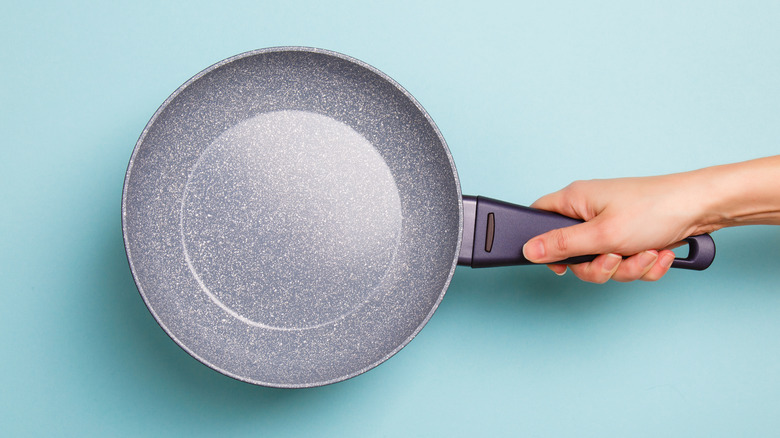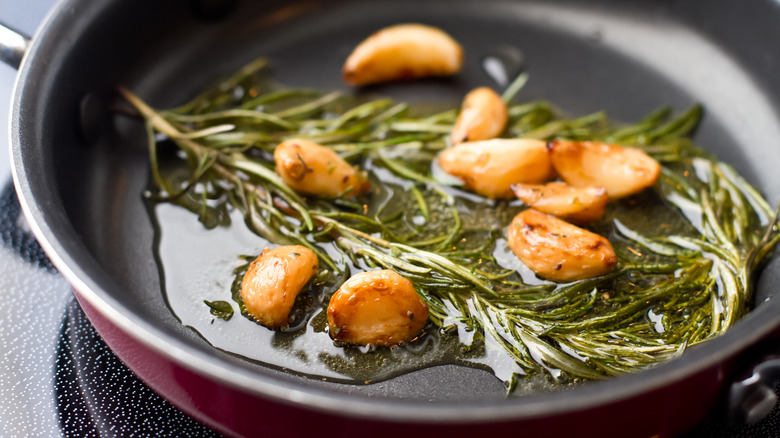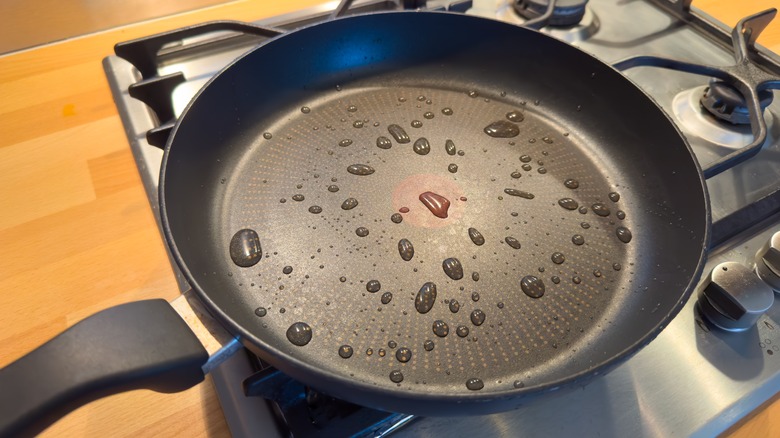The Oil Mistake You're Probably Making With Non-Stick Pans
Non-stick pans have truly changed home cooking for the better. You no longer have to wrestle to keep delicate foods from sticking to the pan and it's far harder to burn dishes with a non-stick surface. With such powers, you may even be tempted to skip the oil you'd usually use to coat them and cook foods. Why splash the extra grease if you don't need to? But, if you're skipping the extra fat source when heating up a non-stick pan, you may be grossly overestimating its abilities. While it is possible to forgo oil, it isn't exactly advisable.
Non-stick pans have a coating of PFAS, or per- and poly-fluoroalkyl substances on their surface. Also known as forever chemicals, PFAS includes the likes of PTFE (commonly dubbed as Teflon) that give non-stick pans their fabulously slippy capabilities. According to Teflon, this chemical coating begins to erode when it reaches a temperature of 348 degrees Celsius (660 degrees Fahrenheit) or higher.
So, when non-stick pans are left to heat sans any oil or grease, they are prone to reach this temperature even quicker and that can gradually ruin them. Unless you want your non-stick pans to lose their great properties, it's best to always use some grease when using them.
While grease is advised, cooking sprays are not
If there's one thing to know about the PFAS chemicals that coat non-stick pans, it's that they can be awfully sensitive and need to be treated with care. Heating pans dry is one mistake that will damage them over time, but that doesn't mean that you can use just any grease. Cooking sprays for one will do just as much harm to your non-stick pans as not using any grease.
Most cooking sprays are nothing except sprayable forms of oil but they contain all sorts of propellants, silicones, and emulsifiers, including lecithin. While these chemicals help lubricate cookware, lecithin in particular doesn't sit well with non-stick pans as it has the tendency to cling onto the non-stick coating — and no amount of hand washing or elbow grease can ever fully get rid of it.
And, the more you use a cooking spray, the more lecithin will build up on your pan over time and form an invisible barrier over the non-stick coating. Eventually, you'll find that your pan no longer has its non-stick abilities as any food you cook in the pan will only stick to this build-up instead.
Best practices for using grease in non-stick pans
While cooking sprays will damage your non-stick pan at best — or invalidate its warranty at worst — using thick and heavy vegetable oil isn't advisable either. This option may leave sediment that could also get in the way of a non-stick pan's coating. That said, it's important to use some form of grease to prevent your non-stick pan from deteriorating over time.
Butter is an excellent option as are vegetable, olive, and grapeseed oils. If you're a stickler for cooking sprays, you could also fill a reusable mister or a spray bottle with your own cooking oil and use that instead — this will give you a DIY cooking spray without the lecithin issues.
Much like seasoning a wok or cast iron, seasoning a non-stick pan will also help to ensure a longer lifespan for its slick coating. To prepare a cold non-stick pan, add a thin layer of cooking oil before you use it for the first time and heat it gently, allowing the oil to seal in. Then, repeat the process every few months. But, regardless of whether you season the pan in advance or not, make sure that you add a few drops of oil (or your choice of grease) when you're ready to cook; heating a non-stick pan when it's dry and empty is rarely a good idea.



